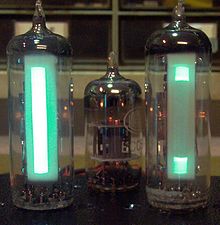

A magic eye tube or tuning indicator, in technical literature called an electron-ray indicator tube,[1] is a vacuum tube which gives a visual indication of the amplitude of an electronic signal, such as an audio output, radio-frequency signal strength, or other functions.[1] The magic eye (also called a cat's eye, or tuning eye in North America) is a specific type of such a tube with a circular display similar to the EM34 illustrated. Its first broad application was as a tuning indicator in radio receivers, to give an indication of the relative strength of the received radio signal, to show when a radio station was properly tuned in.[1]
The magic eye tube was the first in a line of development of cathode ray type tuning indicators developed as a cheaper alternative to needle movement meters. It was not until the 1960s that needle meters were made inexpensively enough in Japan to displace indicator tubes.[2] Tuning indicator tubes were used in vacuum tube receivers from around 1936 to 1980, before vacuum tubes were replaced by transistors in radios.[3] An earlier tuning aid which the magic eye replaced was the "tuneon" neon lamp.[3][4]
- ^ a b c Cite error: The named reference
Spangenberg_1948was invoked but never defined (see the help page). - ^ Cite error: The named reference
Sousa_2006was invoked but never defined (see the help page). - ^ a b Cite error: The named reference
Erb_2009was invoked but never defined (see the help page). - ^ Cite error: The named reference
RM_Tuneonwas invoked but never defined (see the help page).